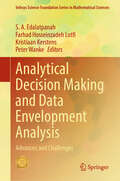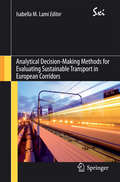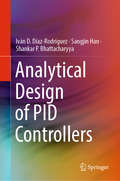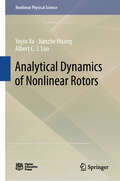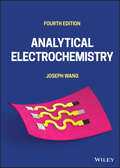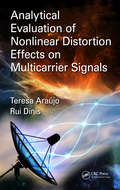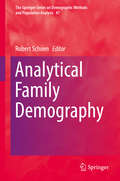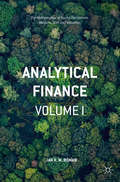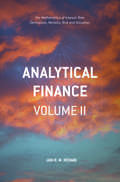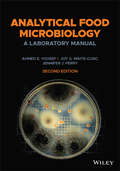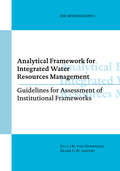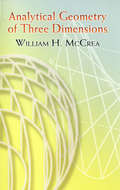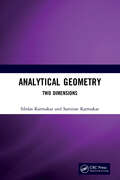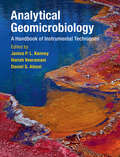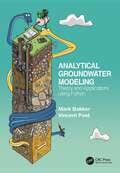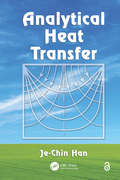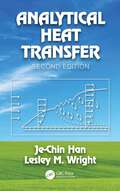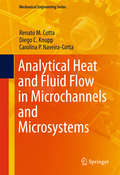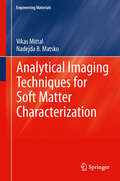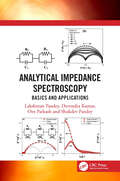- Table View
- List View
Analytical Decision Making and Data Envelopment Analysis: Advances and Challenges (Infosys Science Foundation Series)
by Farhad Hosseinzadeh Lotfi S. A. Edalatpanah Kristiaan Kerstens Peter WankeThis book explores the intersection of data envelopment analysis (DEA) and various analytical decision-making methodologies. Featuring contributions from experts in the field from across the world, each chapter delves into different aspects of DEA and its applications in real-world scenarios. The book covers a wide range of topics, including integrating DEA with machine learning techniques, performance evaluation in diverse sectors like banking and civil engineering, and using DEA in managerial decision-making. It also examines data mining during the Covid-19 pandemic and the application of blockchain and IoT in supply chain management. The book offers a deep dive into the evolution of nonparametric frontier methods and the development of new optimization algorithms, addressing the complexities of modern analytical decision-making tools.A few chapters delve into futuristic topics like fuzzy sets and their extensions in decision-making and exploring e-learning platforms for education. This book is an invaluable resource for researchers, practitioners and students interested in the latest DEA advancements and practical applications in various fields. Its multidisciplinary approach makes it a useful addition to the libraries of those seeking to understand the complexities and potentials of modern analytical decision-making tools.
Analytical Decision-Making Methods for Evaluating Sustainable Transport in European Corridors (SxI - Springer for Innovation / SxI - Springer per l'Innovazione #11)
by Isabella M. LamiEurocorridors are characterized by intensive transport flows and dynamic patterns of establishment and household locations. They are also considered the backbones of powerful spatial and economic forces in the areas that connect urban regions. One of the main difficulties in the spatial planning of eurocorridors has been the need to engage in different types of collective action. Such an approach can be extremely challenging in practice, useful to researchers in the field and to professionals as well. In the light of this, the book's main objectives are: - To define the problem by analyzing the key features, which include freight and passenger transport policies and issues; the territorial context, with its geographical, social, economic and cultural aspects; the plurality of subjects with different aims and resources and the lack of homogeneous information. - To illustrate assessment models and evaluation frameworks (MCDA; Discrete Choice Analysis; Collaborative Assessments; Geovisualization Technologies) in theoretical terms and by the use of case studies.
Analytical Design of PID Controllers
by Shankar P. Bhattacharyya Sangjin Han Iván D. Díaz-RodríguezThis monograph presents a new analytical approach to the design of proportional-integral-derivative (PID) controllers for linear time-invariant plants. The authors develop a computer-aided procedure, to synthesize PID controllers that satisfy multiple design specifications. A geometric approach, which can be used to determine such designs methodically using 2- and 3-D computer graphics is the result.The text expands on the computation of the complete stabilizing set previously developed by the authors and presented here. This set is then systematically exploited to achieve multiple design specifications simultaneously. These specifications include classical gain and phase margins, time-delay tolerance, settling time and H-infinity norm bounds. The results are developed for continuous- and discrete-time systems. An extension to multivariable systems is also included.Analytical Design of PID Controllers provides a novel method of designing PID controllers, which makes it ideal for both researchers and professionals working in traditional industries as well as those connected with unmanned aerial vehicles, driverless cars and autonomous robots.
Analytical Dynamics of Nonlinear Rotors (Nonlinear Physical Science)
by Albert C. Luo Yeyin Xu Jianzhe HuangThis book is a monograph about the analytical dynamics of nonlinear rotor systems. The analytical solutions of periodic motions in nonlinear rotor systems are presented in this book. To help one understand the analytical solutions, the generalized harmonic balance method for periodic motions in polynomial nonlinear systems is briefly reviewed first, and then the semi-analytical method for periodic motions in any nonlinear systems is presented briefly too, which is also called the implicit mapping method. Such two analytical methods are employed to determine the solutions of periodic motions in nonlinear rotor systems. The analytical expressions of periodic motions to chaos for nonlinear rotor systems are presented, and the frequency-amplitude characteristics of nonlinear rotor systems are discussed. In addition, the accurate modeling of nonlinear rotors with oil films is presented, and the periodic motions of such fully nonlinear oil-film rotor systems are developed through the semi-analytical method. This book provides a better understanding of frequency-amplitude characteristics in nonlinear rotor systems. The methodology presented in this book can help one study complicated nonlinear rotor systems.
Analytical Electrochemistry
by Joseph WangANALYTICAL ELECTROCHEMISTRY An accessible and robust text with comprehensive coverage of modern electroanalytical techniques and devices In the newly revised 4th edition of Analytical Electrochemistry, distinguished researcher Dr. Joseph Wang delivers an authoritative and comprehensive discussion of modern electroanalytical techniques and devices. With a strong focus on electroanalysis (as opposed to physical electrochemistry), the book offers readers a thorough grounding in the fundamentals of electrode reactions and the principles of electrochemical methods. It also demonstrates the solving of real-life analytical problems using the techniques discussed within. This latest edition contains extensive updates to the cited literature and its descriptions of various electrochemical processes and techniques. Additional worked examples are included in the text and numerous quantitative questions and exercise problems are found at the end of each chapter. Readers will also find: A thorough introduction to the fundamental concepts of electroanalysis, including discussions of Faradaic processes, electrical double layers, and the electrocapillary effect Comprehensive explorations of the study of electrode reactions, interfacial properties, and controlled potential techniques Practical discussions of the practical considerations of electroanalysis, including electrochemical cells, solvents and supporting electrolytes, and instrumentation Detailed treatments of potentiometry and electrochemical sensors, including ion selective electrodes, electrochemical biosensors and wearable devices Perfect for graduate students studying electroanalytical chemistry, Analytical Electrochemistry will also benefit advanced undergraduate students taking courses in instrumental analysis, as well as academics and industrial professionals considering the use of electroanalysis in their labs.
Analytical Estimates of Structural Behavior
by Clive L. Dym Harry E. WilliamsExplicitly reintroducing the idea of modeling to the analysis of structures, Analytical Estimates of Structural Behavior presents an integrated approach to modeling and estimating the behavior of structures. With the increasing reliance on computer-based approaches in structural analysis, it is becoming even more important for structural engineers
Analytical Evaluation of Nonlinear Distortion Effects on Multicarrier Signals
by Theresa Araújo Rui DinisDue to their ability to support reliable high quality of service as well as spectral and power efficiency, multicarrier modulation systems have found increasing use in modern communications services. However, one of the main drawbacks of these systems is their vulnerability to nonlinear distortion effects. Analytical Evaluation of Nonlinear Distort
Analytical Family Demography (The\springer Series On Demographic Methods And Population Analysis Ser. #47)
by Robert SchoenIn this book new mathematical and statistical techniques that permit more sophisticated analysis are refined and applied to questions of current concern in order to understand the forces that are driving the recent dramatic changes in family patterns. The areas examined include the impact of the evolving Second Demographic Transition, where complex patterns of gender dynamics and social change are re-orienting family life. New analyses of marriage, cohabitation, union dynamics, and union dissolution provide a fresh look at the changing family life cycle, emerging patterns of partner choice, and the impact of union dissolution on the life course. The demography of kinship is explored, and the importance of parity progression to the generation of the kinship web is highlighted. The methodology of population projections by family status is examined, and new results presented that demonstrate how recognizing family status advances long term policy objectives, especially with regard to children and the elderly. This book applies up-to-date methods to examine the demography of the family, and will be of value to sociologists, demographers, and all those who are interested in the family.
Analytical Finance: The Mathematics of Equity Derivatives, Markets, Risk and Valuation
by Jan R. M. RömanThis book provides an introduction to the valuation of financial instruments on equity markets. Written from the perspective of trading, risk management and quantitative research functions and written by a practitioner with many years' experience in markets and in academia, it provides a valuable learning tool for students and new entrants to these markets. Coverage includes: #65533;Trading and sources of risk, including credit and counterparty risk, market and model risks, settlement and Herstatt risks. #65533;Numerical methods including discrete-time methods, finite different methods, binomial models and Monte Carlo simulations. #65533;Probability theory and stochastic processes from the financial modeling perspective, including probability spaces, sigma algebras, measures and filtrations. #65533;Continuous time models such as Black-Scholes-Merton; Delta-hedging and Delta-Gamma-hedging; general diffusion models and how to solve Partial Differential Equation using the Feynmann-Kac representation. #65533;The trading, structuring and hedging several kinds of exotic options, including: Binary/Digital options; Barrier options; Lookbacks; Asian options; Chooses; Forward options; Ratchets; Compounded options; Basket options; Exchange and Currency-linked options; Pay later options and Quantos. #65533;A detailed explanation of how to construct synthetic instruments and strategies for different market conditions, discussing more than 30 different option strategies. With source code for many of the models featured in the book provided and extensive examples and illustrations throughout, this book provides a comprehensive introduction to this topic and will prove an invaluable learning tool and reference for anyone studying or working in this field.
Analytical Finance: The Mathematics of Interest Rate Derivatives, Markets, Risk and Valuation
by Jan R M RömanAnalytical Finance is a comprehensive introduction to the financial engineering of equity and interest rate instruments for financial markets. Developed from notes from the author’s many years in quantitative risk management and modeling roles, and then for the Financial Engineering course at Mälardalen University, it provides exhaustive coverage of vanilla and exotic mathematical finance applications for trading and risk management, combining rigorous theory with real market application.
Analytical Food Microbiology: A Laboratory Manual
by Ahmed E. Yousef Joy G. Waite-Cusic Jennifer J. PerryThe new edition of the highly regarded laboratory manual for courses in food microbiology Analytical Food Microbiology: A Laboratory Manual develops the practical skills and knowledge required by students and trainees to assess the microbiological quality and safety of food. This user-friendly textbook covers laboratory safety, basic microbiological techniques, evaluation of food for various microbiological groups, detection and enumeration of foodborne pathogens, and control of undesirable foodborne microorganisms. Each well-defined experiment includes clear learning objectives and detailed explanations to help learners understand essential techniques and approaches in applied microbiology. The fully revised second edition presents improved conventional techniques, advanced analytical methodologies, updated content reflecting emerging food safety concerns, and new laboratory experiments incorporating commercially available microbiological media. Throughout the book, clear and concise chapters explain culture- and molecular-based approaches for assessing microbial quality and safety of diverse foods. This expanded and updated resource: Reviews aseptic techniques, dilution, plating, streaking, isolation, and other basic microbiological procedures Introduces exercises and relevant microorganisms with pertinent background information and reference material Describes each technique using accessible explanatory text, detailed illustrations, and easy-to-follow flowcharts Employs a proven “building block” approach throughout, with each new chapter building upon skills from the previous chapter Provides useful appendices of microbiological media, recommended control organisms, available supplies and equipment, and laboratory exercise reports With methods drawn from the authors’ extensive experience in academic, regulatory, and industry laboratories, Analytical Food Microbiology: A Laboratory Manual, Second Edition, is ideal for undergraduate and graduate students in food microbiology courses, as well as food processors and quality control personnel in laboratory training programs.
Analytical Fracture Mechanics (Dover Civil and Mechanical Engineering)
by David J. Unger"Analytical Fracture Mechanics should prove to be a valuable resource to both the new student and the experienced researcher in fracture mechanics. It is recommended." -- Applied Mechanics ReviewOne of the central concerns of engineering is the failure of materials. Addressing this concern, fracture mechanics -- an interdisciplinary subject spanning mechanical, civil, and materials engineering, applied mathematics, and physics -- predicts the conditions under which such failure will occur due to crack growth. This valuable self-contained text by an expert in the field supplements standard fracture mechanics texts by focusing on analytical methods for determining crack-tip stress and strain fields.Following a comprehensive 120-page introduction -- which provides all the background necessary for understanding the remaining chapters -- the book is organized around a series of elastoplastic and hydrogen-assisted crack-tip problems and their solutions. The first chapter presents the only proven solution technique for the second order nonlinear partial differential equation governing a mode I elastoplastic crack problem. Other chapters deal with plastic zone transitions, environmental cracking, and small-scale yielding versus exact linear elastic solutions.One of the excellent features of this book is the clarity with which groups of problems are presented and related to each other. Another is the careful attention it gives to the various modes of fracture (I, II, and III) and to showing the circumstances under which information from a solution for one mode may be used to infer information in another mode. For this edition, the author has added a new appendix, "Stress Across an Elastoplastic Boundary of a Mode I Crack: Parabolic to Hyperbolic Plasticity Transition."
Analytical Framework for Integrated Water Resources Management: IHE monographs 2
by Paul van Hofwegen Frank G.W. JaspersThis monograph provides a framework and guidelines for the assessment of institutional frameworks for integrated water resources management (IWRM). The framework and guidelines were developed to enable expert teams of the Inter-American Development Bank to incorporate capacity-building considerations into water-related projects. The framework and guidelines were tested in four countries with different physical, social and economic environments in Latin America and the Caribbean. Using this framework, it is possible to identify shortcomings in existing water management arrangements and to formulate interventions at and between the constitutional, organizational, and operational levels. To guide the formulation of interventions, an ideal IWRM situation is formulated. Due to the temporal and spatial specificity, a desired IWRM situation is formulated in a process which consists of ten operational steps. This process is based on an extensive consultation and participation of all relevant stakeholders. The fields of interventions concern awareness creation, policy development, legal and financial arrangements, human resources development and management information and decision support systems.
Analytical Geometry of Three Dimensions: Second Revised Version
by William H. McCreaBrief but rigorous, this text is geared toward advanced undergraduates and graduate students. It covers the coordinate system, planes and lines, spheres, homogeneous coordinates, general equations of the second degree, quadric in Cartesian coordinates, and intersection of quadrics.Mathematician, physicist, and astronomer, William H. McCrea conducted research in many areas and is best known for his work on relativity and cosmology. McCrea studied and taught at universities around the world, and this book is based on a series of his lectures.
Analytical Geometry: Two Dimensions
by Sibdas Karmakar Samiran KarmakarThis book is a compilation of all basic topics of Analytical Geometry of Two Dimensions and is intended to serve as an introductory text aimed towards undergraduate and graduate students in science and technology. An understanding of basic school level algebra and geometry can serve as the prerequisite for following this book. The present work is no original work but an attempt to make the subject thoroughly intelligible. All the important properties of the conics have been discussed either in the articles or in illustrative examples. Each chapter has sufficient completely solved problems and a set of carefully graded and motivating unsolved exercises. Please note: Taylor & Francis does not sell or distribute the Hardback in India, Pakistan, Nepal, Bhutan, Bangladesh and Sri Lanka.
Analytical Geomicrobiology: A Handbook of Instrumental Techniques
by Kenney Janice P. L. Harish Veeramani Daniel S. AlessiGeomicrobiology is the study of microbes and microbial processes and their role in driving environmental and geological processes at scales ranging from the nano, micron, to meter scale. This growing field has seen major advances in recent years, largely due to the development of new analytical tools and improvements to existing techniques, which allow us to better understand the complex interactions between microbes and their surroundings. In this comprehensive handbook, expert authors outline the state-of-the-art and emerging analytical techniques used in geomicrobiology. Readers are guided through each technique including background theory, sample preparation, standard methodology, data collection and analysis, best practices and common pitfalls, and examples of how and where the technique has been applied. The book provides a practical go-to reference for advanced students, researchers and professional scientists looking to employ techniques commonly used in geomicrobiology.
Analytical Groundwater Mechanics
by Otto D. L. StrackGroundwater mechanics is the study of fluid flow in porous media. Focusing on applications and case studies, this book explains the basic principles of groundwater flow using mathematical expressions to describe a wide range of different aquifer configurations. Emphasis is placed throughout on the importance of developing simplified models that can be solved analytically to provide insight into complex groundwater flow scenarios and to allow better interpretation of the full numerical solution. Focusing first on identifying the important features of a problem, the book explains how to translate practical questions into mathematical form and discusses the interpretation of the results. Illustrated with numerous real-world examples and graphical results, this is an ideal textbook for advanced undergraduate and graduate Earth science, geological engineering, and environmental engineering courses, as well as a useful reference for researchers and professionals.
Analytical Groundwater Modeling: Theory and Applications using Python
by Vincent Post Mark BakkerThis book provides a detailed description of how Python can be used to give insight into the flow of groundwater based on analytic solutions. Starting with simple problems to illustrate the basic principles, complexity is added step by step to show how one-dimensional and two-dimensional models of one or two aquifers can be implemented. Steady and transient flow problems are discussed in confined, semi-confined, and unconfined aquifers that may include wells, rivers, and areal recharge. Special consideration is given to coastal aquifers, including the effect of tides and the simulation of interface flow. Application of Python allows for compact and readable code, and quick visualization of the solutions. Python scripts are provided to reproduce all results. The scripts are also available online so that they can be altered to meet site-specific conditions. This book is intended both as training material for the next generation of university students and as a useful resource for practitioners. A primer is included for those who are new to Python or as a refresher for existing users.
Analytical Heat Transfer
by Je-Chin HanFilling the gap between basic undergraduate courses and advanced graduate courses, this text explains how to analyze and solve conduction, convection, and radiation heat transfer problems analytically. It describes many well-known analytical methods and their solutions, such as Bessel functions, separation of variables, similarity method, integral method, and matrix inversion method. Developed from the author's 30 years of teaching, the text also presents step-by-step mathematical formula derivations, analytical solution procedures, and numerous demonstration examples of heat transfer applications.
Analytical Heat Transfer
by Je-Chin Han Lesley M. WrightAnalytical Heat Transfer explains how to analyze and solve conduction, convection, and radiation heat transfer problems. It enables students to tackle complex engineering heat transfer problems prevalent in practice. Covering heat transfer in high-speed flows and unsteady highly turbulent flows, the book also discusses enhanced heat transfer in channels, heat transfer in rotating channels, numerical modeling for turbulent flow heat transfer, and thermally developing heat transfer in a circular tube. The second edition features new content on Duhamel’s superposition method, Green’s function method for transient heat conduction, finite-difference method for steady state and transient heat conduction in cylindrical coordinates, and laminar mixed convection. It includes two new chapters on laminar-to-turbulent transitional heat transfer and turbulent flow heat transfer enhancement, in addition to end-of-chapter problems. The book bridges the gap between basic heat transfer undergraduate courses and advanced heat transfer graduate courses for a single semester of intermediate heat transfer, advanced conduction/radiation heat transfer, or convection heat transfer. Features: Focuses on analyzing and solving classic heat transfer problems in conduction, convection, and radiation Covers 2-D and 3-D view factor evaluation, combined radiation with conduction and/or convection, and gas radiation optically thin and optically thick limits Features updated content and new chapters on mass and heat transfer analogy, thermally developing heat transfer in a circular tube, laminar-turbulent transitional heat transfer, unsteady highly turbulent flows, enhanced heat transfer in channels, heat transfer in rotating channels, and numerical modeling for turbulent flow heat transfer Provides step-by-step mathematical formula derivations, analytical solution procedures, and demonstration examples Includes end-of-chapter problems with an accompanying Solutions Manual for instructors This book is ideal for undergraduate and graduate students studying basic heat transfer and advanced heat transfer.
Analytical Heat and Fluid Flow in Microchannels and Microsystems (Mechanical Engineering Series)
by Renato M. Cotta Diego C. Knupp Carolina P. Naveira-CottaThis book focuses on the modeling and analysis of heat and fluid flow in microchannels and micro-systems, compiling a number of analytical and hybrid numerical-analytical solutions for models that account for the relevant micro-scale effects, with the corresponding experimental analysis validation when applicable. The volume stands as the only available compilation of easy to use analytically-based solutions for micro-scale heat and fluid flow problems, that systematically incorporates the most relevant micro-scale effects into the mathematical models, followed by their physical interpretation on the micro-system behavior.
Analytical Hypnotherapy, Volume 1: Theoretical Principles
by Jacquelyne MorisonThe first volume of a two-volume work. Analytical hypnotherapy is the use of hypnosis to uncover and deal with inner conflicts.
Analytical Hypnotherapy, Volume 2: Practical Applications
by Jacquelyne MorisonThe second volume of a two-volume work. Analytical hypnotherapy is the use of hypnosis to uncover and deal with inner conflicts.
Analytical Imaging Techniques for Soft Matter Characterization (Engineering Materials)
by Vikas Mittal Nadejda B. MatskoThe book aims to describe the microscopic characterization of the soft matter in the light of new advances acquired in the science of microscopy techniques like AFM; SEM; TEM etc. It does not focus on the traditional information on the microscopy methods as well as systems already present in different books, but intends to answer more fundamental questions associated with commercially important systems by using new advances in microscopy. Such questions are generally not answered by other techniques. The contents of the book also reflect this as the chapters are not based on describing only material systems, but are based on the answering the problems or questions arising in their characterization. Both qualitative as well as quantitative analysis using such microscopic techniques is discussed. Moreover, efforts have been made to provide a broader reach as discussions on both polymers as well as biological matter have been included as different sections. Such a text with comprehensive overview of the various characterization possibilities using microscopy methods can serve as a valuable reference for microscopy experts as well as non-experts alike
Analytical Impedance Spectroscopy: Basics and Applications
by Devendra Kumar Lakshman Pandey Om Parkash Shukdev PandeyThis book introduces the subject of impedance spectroscopy starting from fundamentals through to latest applications in areas such as ceramics, piezoelectric, sensors, agriculture, food quality control, medical diagnostics, cancer research, and so forth. Within the ambit of impedance spectroscopy, plots simulated for useful equivalent circuit models, design of sample holder, necessary precautions to be taken during measurement are described. It further discusses development of softwares for analysis of experimental data and choice of the most appropriate equivalent circuit model. All the materials are supported by problems, answers, appendices and references. Features: Includes fundamentals, equivalent circuit modeling and analysis of data related to impedance spectroscopy. Presents experimental measurements in a nuts-and-bolts approach. Includes derivation of expressions for some selected models and values of immittance functions as frequency of measurements tend to zero and to infinity. Provides clear recipe for beginners for proceeding toward developing equivalent circuit models. Describes computer program for complex nonlinear least squares fitting with example of program IMPSPEC.BAS This book is aimed at senior undergraduate/graduate students and researchers in materials engineering, mechanical engineering, electrical engineering, chemical engineering, biomedical engineering, construction engineering, physics, chemistry, medical diagnostics, agriculture and dairy.
